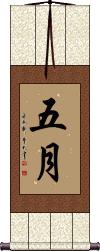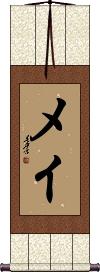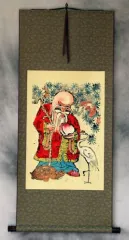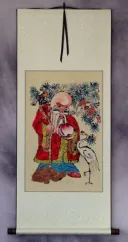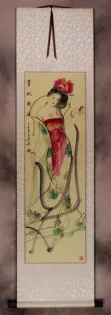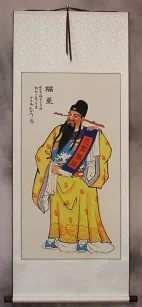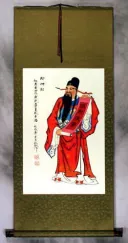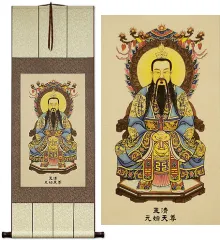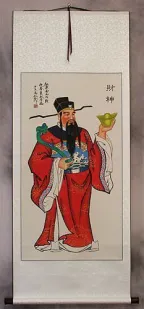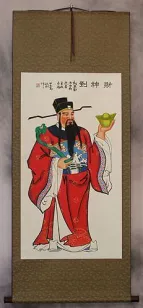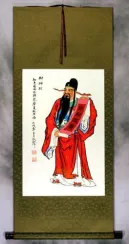Many custom options...
And formats...

May in Chinese / Japanese...
Buy a May calligraphy wall scroll here!
Personalize your custom “May” project by clicking the button next to your favorite “May” title below...
Beauty / Beautiful / Handsome
美 is often used to describe the beauty of a woman.
However, when applied to a man, it can mean handsome. It's also the first character in the word for “beauty salon” which you will see all over China and Japan.
This can be used as the given name for a girl (spell it or say it as “Mei” or “May”).
For a bit of trivia: The title for the “USA” in Chinese is “Mei Guo” which literally means “Beautiful Country.” This name was bestowed at a time before Chairman Mao came to power and decided that China didn't like the USA anymore (even though we fought together against the Japanese in WWII). But these days, Chinese people love Americans (but have a distaste for American politics and policy). But I digress...
美 is also how “Beautiful” is written in Japanese Kanji and Korean Hanja. 美 can also mean: very satisfactory; good; to be pleased with oneself; abbreviation for the USA; fine; handsome; admirable; madhura; sweet; and/or pleasant.
See Also: Beautiful Woman | Beautiful Girl
The Month of May
Fifth Month
五月 is the month of May in Chinese, Japanese Kanji, and old Korean Hanja.
This was originally the fifth month of the Chinese lunar year, now used for the fifth month of the Gregorian calendar (also known as the Western or Christian calendar). 五月 literally means “fifth month” or “fifth moon.”
Note: Sometimes Japanese parents will use this as a female given name, and use "Mei" (the sound of May in English) as the pronunciation.
This is a common transliteration to Mandarin Chinese for the name May.
梅 actually means “plum blossom.” This is a common name for girls in China.
This in-stock artwork might be what you are looking for, and ships right away...
Gallery Price: $200.00
Your Price: $69.88
Gallery Price: $200.00
Your Price: $69.88
Gallery Price: $268.00
Your Price: $148.88
These search terms might be related to May:
A House Might Be Worth 1 Million Dollars, but Good Neighbors Are Worth 10 Million
Any Success Can Not Compensate for Failure in the Home
Black or White Cat Matters Not as Long as It Can Catch Mice
Even an Iron Bar Can Be Ground to a Needle
Even the 100-Foot Bamboo Can Grow One More Foot
How Can You Catch Tiger Cubs Without Entering the Lair of the Tiger?
If You Have Not Been a Monk, How Can You Know What It is Like to Be a Vegetarian?
Never Put Off Until Tomorrow What You Can Do Today
Not Only Can Water Float a Boat, It Can Sink It Also
One Justice Can Overpower 100 Evils
Only God Can Judge Me
Without a Big Net, How Can You Catch Fish?
Not the results for may that you were looking for?
Below are some entries from our dictionary that may match your may search...
| Characters If shown, 2nd row is Simp. Chinese |
Pronunciation Romanization |
Simple Dictionary Definition |
堪 see styles |
kān kan1 k`an kan tan たん |
More info & calligraphy: Kane(personal name) Tan To bear, sustain, be adequate to. |
身 see styles |
shēn shen1 shen mi み |
More info & calligraphy: Body(1) one's body; one's person; (2) oneself; one's appearance; (3) one's place (in society, etc.); one's position; (4) main part; meat (as opposed to bone, skin, etc.); wood (as opposed to bark); blade (as opposed to its handle); container (as opposed to its lid); (surname) Misaki kāya; tanu; deha. The body; the self.; Two forms of body; there are numerous pairs, e. g. (1) (a) 分段身 The varied forms of the karmic or ordinary mortal body, or being; (b) 變易身 the transformable, or spiritual body. (2) (a) 生身 The earthly body of the Buddha; (b) 化身 hinirmāṇakāya, which may take any form at will. (3) (a) 生身 his earthly body; (b) 法身 his moral and mental nature—a Hīnayāna definition, but Mahāyāna takes his earthly nirmāṇakāya as the 生身 and his dharmakāya or that and his saṃbhogakāya as 法身. (4) 眞應二身 The dharmakāya and nirmāṇakāya. (5) (a) 實相身 The absolute truth, or light, of the Buddha, i. e. the dharmakāya; (b) 爲物身 the functioning or temporal body. (6) (a) 眞身 the dharmakāya and saṃbhogakāya; (b) 化身 the nirmāṇakāya. (7) (a) 常身 his permanent or eternal body; (b) 無常身 his temporal body. (8) (a) 實身 and 化身 idem 二色身. |
かも see styles |
kamo かも |
(particle) (abbreviation) (See かもしれない) may; might; perhaps; may be; possibly |
めい see styles |
mei / me メイ |
May; (female given name) Mei; Mae; May |
三昧 see styles |
sān mèi san1 mei4 san mei sanmai; zanmai さんまい; ざんまい |
More info & calligraphy: Samadhi(1) (さんまい only) {Buddh} samadhi (state of intense concentration achieved through meditation) (san:); (suffix noun) (2) (usu. ざんまい) being immersed in; being absorbed in; indulging in; doing to one's heart's content; (suffix noun) (3) (usu. ざんまい) prone to; apt to; (given name) Sanmai (三昧地) Samādhi, "putting together, composing the mind, intent contemplation, perfect absorption, union of the meditator with the object of meditation." (M. W.) Also 三摩地 (三摩提, 三摩帝, 三摩底). Interpreted by 定 or 正定, the mind fixed and undisturbed; by 正受 correct sensation of the object contemplated; by 調直定 ordering and fixing the mind; by 正心行處 the condition when the motions of the mind are steadied and harmonized with the object; by 息慮凝心 the cessation of distraction and the fixation of the mind; by 等持 the mind held in equilibrium; by 奢摩他, i.e. 止息 to stay the breathing. It is described as concentration of the mind (upon an object). The aim is 解脫, mukti, deliverance from all the trammels of life, the bondage of the passions and reincarnations. It may pass from abstraction to ecstasy, or rapture, or trance. Dhyāna 定 represents a simpler form of contemplation; samāpatti 三摩鉢底 a stage further advanced; and samādhi the highest stage of the Buddhist equivalent for Yoga, though Yoga is considered by some as a Buddhist development differing from samādhi. The 翻譯名義 says: 思專 when the mind has been concentrated, then 志一不分 the will is undivided; when 想寂 active thought has been put to rest, then 氣虛神朗 the material becomes etherealized and the spirit liberated, on which 智 knowledge, or the power to know, has free course, and there is no mystery into which it cannot probe. Cf. 智度論 5, 20, 23, 28; 止觀 2; 大乘義章 2, 9, 1 3, 20, etc. There are numerous kinds and degrees of samādhi. |
三諦 三谛 see styles |
sān dì san1 di4 san ti santai; sandai さんたい; さんだい |
More info & calligraphy: The Three TruthsThe three dogmas. The "middle" school of Tiantai says 卽空, 卽假. 卽中 i.e. 就是空, 假, 中; (a) by 空śūnya is meant that things causally produced are intheir essential nature unreal (or immaterial) 實空無; (b) 假, though thingsare unreal in their essential nature their derived forms are real; (c) 中;but both are one, being of the one 如 reality. These three dogmas arefounded on a verse of Nāgārjuna's— 因緣所生法, 我說卽是空 亦爲是假名, 亦是中道義 "All causally produced phenomena, I say, areunreal, Are but a passing name, and indicate the 'mean'." There are otherexplanations— the 圓教 interprets the 空 and 假 as 中; the 別教 makes 中 independent. 空 is the all, i.e. the totality of all things, and is spokenof as the 眞 or 實 true, or real; 假 is the differentiation of all thingsand is spoken of as 俗 common, i.e. things as commonly named; 中 is theconnecting idea which makes a unity of both, e.g. "all are but parts of onestupendous whole." The 中 makes all and the all into one whole, unifying thewhole and its parts. 空 may be taken as the immaterial, the undifferentiatedall, the sum of existences, by some as the tathāgatagarbha 如來藏; 假as theunreal, or impermanent, the material or transient form, the temporal thatcan be named, the relative or discrete; 中 as the unifier, which places eachin the other and all in all. The "shallower" 山外 school associated 空 and 中 with the noumenal universe as opposed to the phenomenal and illusoryexistence represented by 假. The "profounder" 山内 school teaches that allthree are aspects of the same. |
五月 see styles |
wǔ yuè wu3 yue4 wu yüeh mei / me めい |
More info & calligraphy: The Month of May(1) (obsolete) fifth month of the lunar calendar; (2) (kana only) satsuki azalea (Rhododendron indicum); (adverbial noun) May; (female given name) Mei |
四諦 四谛 see styles |
sì dì si4 di4 ssu ti shitai したい |
More info & calligraphy: Four Noble Truths (Buddhism){Buddh} (See 苦集滅道) The Four Noble Truths catvāri-ārya-satyāni; 四聖諦; 四眞諦. The four dogmas, or noble truths, the primary and fundamental doctrines of Śākyamuni, said to approximate to the form of medical diagnosis. They are pain or 'suffering, its cause, its ending, the way thereto; that existence is suffering, that human passion (taṇhā, 欲 desire) is the cause of continued suffering, that by the destruction of human passion existence may be brought to an end; that by a life of holiness the destruction of human passion may be attained'. Childers. The four are 苦, 聚 (or 集), 滅, and 道諦, i. e. duḥkha 豆佉, samudaya 三牟提耶, nirodha 尼棲陀, and mārga 末加. Eitel interprets them (1) 'that 'misery' is a necessary attribute of sentient existence'; (2) that 'the 'accumulation' of misery is caused by the passions'; (3) that 'the 'extinction' of passion is possible; (4) mārga is 'the doctrine of the 'path' that leads to the extinction of passion'. (1) 苦 suffering is the lot of the 六趣 six states of existence; (2) 集 is the aggregation (or exacerbation) of suffering by reason of the passions; (3) 滅 is nirvana, the extinction of desire and its consequences, and the leaving of the sufferings of mortality as void and extinct; (4) 道 is the way of such extinction, i. e. the 八正道 eightfold correct way. The first two are considered to be related to this life, the last two to 出世間 a life outside or apart from the world. The four are described as the fundamental doctrines first preached to his five former ascetic companions. Those who accepted these truths were in the stage of śrāvaka. There is much dispute as to the meaning of 滅 'extinction' as to whether it means extinction of suffering, of passion, or of existence. The Nirvana Sutra 18 says that whoever accepts the four dogmas will put an end to births and deaths 若能見四諦則得斷生死 which does not of necessity mean the termination of existence but that of continued transmigration. v. 滅. |
地獄 地狱 see styles |
dì yù di4 yu4 ti yü jigoku じごく |
More info & calligraphy: Hell(1) {Buddh} hell realm; Naraka; (2) {Christn} Hell; (3) hell; misery; nightmare; inferno; (4) place where a volcano or hot springs constantly spew smoke or steam; (place-name) Jigoku naraka, 捺落迦 (or 那落迦) ; niraya 泥犂; explained by 不樂 joyless; 可厭 disgusting, hateful; 苦具, 苦器 means of suffering; if 地獄 earth-prison; 冥府 the shades, or departments of darkness. Earth-prison is generally intp. as hell or the hells; it may also be termed purgatory; one of the six gati or ways of transmigration. The hells are divided into three classes: I. Central, or radical, 根本地獄 consisting of (1) The eight hot hells. These were the original hells of primitive Buddhism, and are supposed to be located umder the southern continent Jambudvīpa 瞻部州, 500 yojanas below the surface. (a) 等活 or 更活 Saṃjīva, rebirth, where after many kinds of suffering a cold wind blows over the soul and returns it to this life as it was before, hence the name 等活. (b) 黑繩 Kaslasūtra, where the sufferer is bound with black chains and chopped or sawn asunder. (c) 線合; 衆合; 堆壓 Saṃghāta, where are multitudes of implements of torture, or the falling of mountains upon the sufferer. (d) 號呌; 呼呼; 叫喚 Raurava, hell of wailing. (e) 大呌; 大號呌; 大呼 Mahāraurava, hell of great wailing. (f) 炎熱; 燒炙 Tapana, hell of fames and burning. (g) 大熱; 大燒炙; 大炎熱 Pratāpana, hell of molten lead. (h) 無間; 河鼻旨; 阿惟越致; 阿毗至; 阿鼻; 阿毗 Avīci, unintermitted suffering, where sinners die and are reborn to suffer without interval. (2) The eight cold hells 八寒地獄. (a) 頞浮陀地獄 Arbuda, where the cold causes blisters. (b) 尼刺部陀 Nirarbuda, colder still causing the blisters to burst. (c) 頞哳吒; 阿吒吒 Atata, where this is the only possible sound from frozen lips. (d) 臛臛婆; 阿波波 Hahava or Apapa, where it is so cold that only this sound can be uttered. (e) 虎虎婆 Hāhādhara or Huhuva, where only this sound can be uttered. (f) 嗢鉢羅; 鬱鉢羅 (or 優鉢羅) Utpala, or 尼羅鳥 (or 漚) 鉢羅 Nīlotpala, where the skin is frozen like blue lotus buds. (g) 鉢特摩 Padma, where the skin is frozen and bursts open like red lotus buds. (h) 摩訶鉢特摩 Mahāpadma, ditto like great red lotus buds. Somewhat different names are also given. Cf. 倶舍論 8; 智度論 16; 涅槃經 11. II. The secondary hells are called 近邊地獄 adjacent hells or 十六遊增 each of its four sides, opening from each such door are four adjacent hells, in all sixteen; thus with the original eight there are 136. A list of eighteen hells is given in the 十八泥梨經. III. A third class is called the 孤地獄 (獨地獄) Lokāntarika, or isolated hells in mountains, deserts, below the earth and above it. Eitel says in regard to the eight hot hells that they range 'one beneath the other in tiers which begin at a depth of 11,900 yojanas and reach to a depth of 40,000 yojanas'. The cold hells are under 'the two Tchahavālas and range shaft-like one below the other, but so that this shaft is gradually widening to the fourth hell and then narrowing itself again so that the first and last hell have the shortest, those in the centre the longest diameter'. 'Every universe has the same number of hells, ' but 'the northern continent has no hell whatever, the two continents east and west of Meru have only small Lokāntarika hells... whilst all the other hells are required for the inhabitants of the southern continent '. It may be noted that the purpose of these hells is definitely punitive, as well as purgatorial. Yama is the judge and ruler, assisted by eighteen officers and a host of demons, who order or administer the various degrees of torture. 'His sister performs the same duties with regard to female criminals, ' and it may be mentioned that the Chinese have added the 血盆池 Lake of the bloody bath, or 'placenta tank' for women who die in childbirth. Release from the hells is in the power of the monks by tantric means. |
寿司 see styles |
hisashi ひさし |
More info & calligraphy: Sushi |
精進 精进 see styles |
jīng jìn jing1 jin4 ching chin shoujin(p); soujin(ok); shouji(ok); souji(ok) / shojin(p); sojin(ok); shoji(ok); soji(ok) しょうじん(P); そうじん(ok); しょうじ(ok); そうじ(ok) |
More info & calligraphy: Devotion / Diligence / Vigorous / Energetic(n,vs,vi) (1) concentration; diligence; devotion; (n,vs,vi) (2) {Buddh} (See 六波羅蜜) asceticism; zeal in one's quest for enlightenment; (n,vs,vi) (3) adherence to a vegetarian diet; (surname) Shoujin vīrya, one of the seven bodhyaṅga; 'vigour,' 'valour, fortitude,' 'virility' (M.W.); 'welldoing' (Keith). The Chinese interpretation may be defined, as pure or unadulterated progress, i.e. 勤 zeal, zealous, courageously progressing in the good and eliminating the evil.; vīrya, zeal, unchecked progress. |
長女 长女 see styles |
zhǎng nǚ zhang3 nu:3 chang nü choujo / chojo ちょうじょ |
More info & calligraphy: First Born Daughter(may be the only daughter) eldest daughter; first-born daughter; (given name) Osame |
長男 长男 see styles |
zhǎng nán zhang3 nan2 chang nan chounan / chonan ちょうなん |
More info & calligraphy: First Born Soneldest son (may be the only son); first-born son; (personal name) Nobuo |
活人剣 see styles |
katsujinken; katsuninken かつじんけん; かつにんけん |
More info & calligraphy: Life-Saving Sword |
五福臨門 五福临门 see styles |
wǔ fú lín mén wu3 fu2 lin2 men2 wu fu lin men |
More info & calligraphy: Blessings on this Home |
千慮一得 千虑一得 see styles |
qiān lǜ yī dé qian1 lu:4 yi1 de2 ch`ien lü i te chien lü i te senryoittoku; senryonoittoku せんりょいっとく; せんりょのいっとく |
More info & calligraphy: Even a fool may sometimes come up with a good idea(expression) (yoji) even a fool may sometimes come up with a good idea |
年年有餘 年年有余 see styles |
nián nián yǒu yú nian2 nian2 you3 yu2 nien nien yu yü |
More info & calligraphy: Year-In Year-Out Have Abundance |
百年好合 see styles |
bǎi nián hǎo hé bai3 nian2 hao3 he2 pai nien hao ho |
More info & calligraphy: 100 Years of Happy Marriage |
萬事如意 万事如意 see styles |
wàn shì rú yì wan4 shi4 ru2 yi4 wan shih ju i |
More info & calligraphy: All Hopes Fulfilled |
阿彌陀佛 阿弥陀佛 see styles |
ē mí tuó fó e1 mi2 tuo2 fo2 o mi t`o fo o mi to fo Amida butsu |
More info & calligraphy: Amitabha BuddhaAmitâbha Buddha |
令 see styles |
lìng ling4 ling rei / re れい |
to order; to command; an order; warrant; writ; to cause; to make something happen; virtuous; honorific title; season; government position (old); type of short song or poem (n,n-suf) (1) command; order; dictation; (prefix) (2) (See 令和) nth year in the Reiwa era (May 1, 2019-); (personal name) Reiji cause |
伊 see styles |
yī yi1 i i い |
(old) third person singular pronoun ("he" or "she"); second person singular pronoun ("you"); (May 4th period) third person singular feminine pronoun ("she"); (Classical Chinese) introductory particle with no specific meaning; that (preceding a noun) (abbreviation) (See 伊太利・イタリア) Italy; (personal name) Yoshi He, she, it; that; translit. i, ai, ṛ; cf. 壹, 彝 and 意; for the long ī the double characters 翳吚 and 伊伊 are sometimes used. |
勿 see styles |
wù wu4 wu motsu まな |
do not (adverb) (archaism) must not; may not Not; do not; translit. m and v. |
可 see styles |
kè ke4 k`o ko ka か |
used in 可汗[ke4 han2] (n,n-suf) (1) acceptable; satisfactory; allowed; permitted; (2) approval; being in favour; (a) vote in favour; aye; (3) (on a 優, 良, 可 scale) Pass (grade); Fair; C; D; (surname) Ha May, can, able. |
叵 see styles |
pǒ po3 p`o po ha |
not; thereupon May not, cannot; translit. ph. |
哦 see styles |
o o5 o ga |
sentence-final particle that conveys informality, warmth, friendliness or intimacy; may also indicate that one is stating a fact that the other person is not aware of Translit. ga; cf. 我, 誐, 伽, M003598, 疙. |
塵 尘 see styles |
chén chen2 ch`en chen chiri ちり |
dust; dirt; earth (1) dust; (2) trash; garbage; rubbish; dirt; (3) (usu. as 塵ほども...ない) negligible amount; tiny bit; (4) hustle and bustle (of life); worldly cares; impurities of the world; (5) (abbreviation) {sumo} (See 塵手水) ritual gestures indicating that a fight will be clean guṇa, in Sanskrit inter alia means 'a secondary element', 'a quality', 'an attribute of the five elements', e.g. 'ether has śabda or sound for its guṇa and the ear for its organ'. In Chinese it means 'dust, small particles; molecules, atoms, exhalations'. It may be intp. as an atom, or matter, which is considered as defilement; or as an active, conditioned principle in nature, minute, subtle, and generally speaking defiling to pure mind; worldly, earthly, the world. The six guṇas or sensation-data are those of sight, sound, smell, taste, touch, and thought. |
巳 see styles |
sì si4 ssu mi(p); shi み(P); し |
6th earthly branch: 9-11 a.m., 4th solar month (5th May-5th June), year of the Snake; ancient Chinese compass point: 150° (1) the Snake (sixth sign of the Chinese zodiac); the Serpent; (2) (obsolete) (See 巳の刻) hour of the Snake (around 10am, 9-11am, or 10am-12 noon); (3) (obsolete) south-southeast; (4) (obsolete) fourth month of the lunar calendar; (female given name) Mi snake |
敢 see styles |
gǎn gan3 kan tsuyoshi つよし |
to dare; daring; (polite) may I venture (personal name) Tsuyoshi To dare, venture. |
楝 see styles |
liàn lian4 lien sendan せんだん ouchi / ochi おうち |
Melia japonica (1) (kana only) chinaberry; Japanese bead tree (Melia azedarach); (2) Indian sandalwood (Santalum album); (1) (archaism) chinaberry; Japanese bead tree (Melia azedarach); (2) light purple outside, green inside; purple outside, light purple inside; type of garment layering color scheme, worn in April and May |
Click here for more may results from our dictionary
The following table may be helpful for those studying Chinese or Japanese...
| Title | Characters | Romaji (Romanized Japanese) | Various forms of Romanized Chinese | |
| Beauty Beautiful Handsome | 美 | bi | měi / mei3 / mei | |
| The Month of May | 五月 | satsuki / go gatsu satsuki / gogatsu | wǔ yuè / wu3 yue4 / wu yue / wuyue | wu yüeh / wuyüeh |
| May | 梅 | méi / mei2 / mei | ||
| May | メイ | mei | ||
| In some entries above you will see that characters have different versions above and below a line. In these cases, the characters above the line are Traditional Chinese, while the ones below are Simplified Chinese. | ||||
Successful Chinese Character and Japanese Kanji calligraphy searches within the last few hours...

